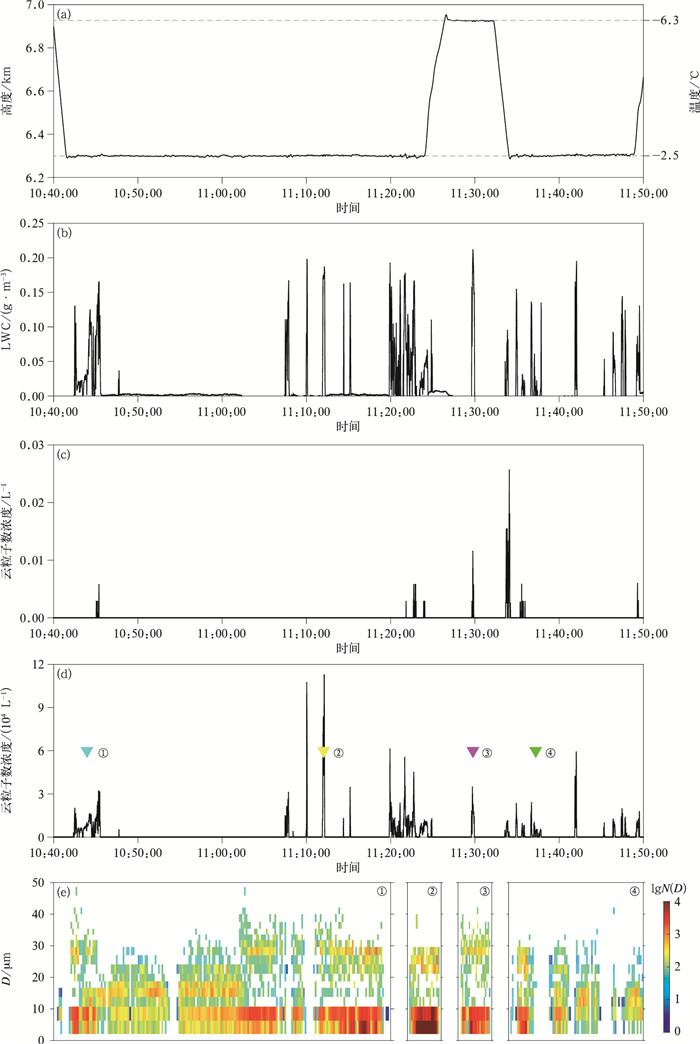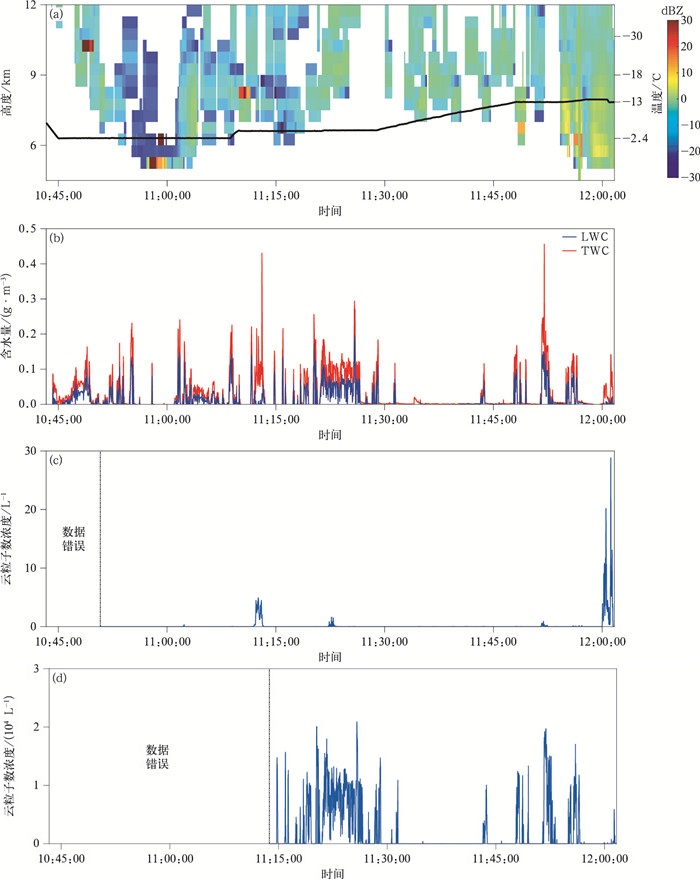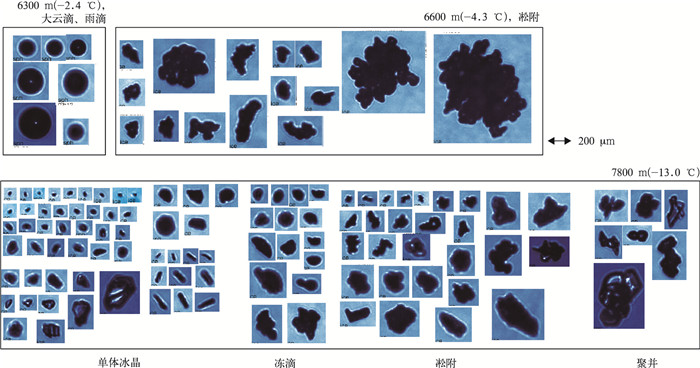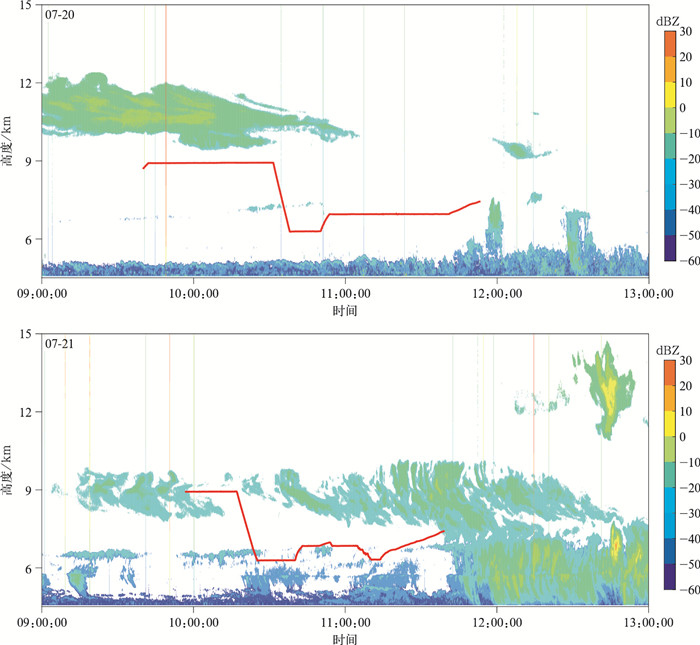Microphysical Characteristics and Precipitation Formation Mechanisms of Convective Clouds over the Tibetan Plateau in Summer
-
摘要: 青藏高原对我国天气、气候和水循环过程有重要影响。利用第三次青藏高原大气科学试验(TIPEX-Ⅲ)2014年7月在那曲地区的飞机观测数据,研究青藏高原夏季对流云和降水的微物理特征及降水形成机制。飞机探测的云系主要为初生或发展阶段的冰水混合云,云滴数浓度低于平原、海洋地区1~2个量级,云内存在大量大云滴和雨滴,过冷水含量高。大粒子(D≥50 μm)数浓度量级为100~101 L-1,云内上升气流速度集中在1~4 m·s-1。青藏高原云滴谱主要呈双峰型,云内冰相粒子多为密实、不透明的霰粒子,云内凇附过程显著。云内暖雨过程产生的大云滴和雨滴有利于冰相过程,尤其是凇附过程的产生,使得青藏高原云更易产生降水。此外,残留云系与对流云有着较为类似的微物理特征。Abstract: Tibetan Plateau (TP) has high impact on weather, climate, and water cycle of China, and it also affects the flood and drought in south China by modulating the onset and retreat of the Asian monsoon. However, owning to the lack of direct observations, the knowledge of microphysical characteristics and mechanisms inside the clouds over TP is still seriously lacking. During the Third Tibetan Plateau Atmospheric Scientific Experiment (TIPEX-Ⅲ), field observations is carried out in the summer of 2014, which employed ground-based and airborne instruments. By using the aircraft measurements collected during the TIPEX-Ⅲ, the microphysical characteristics and precipitation formation mechanisms of summertime clouds are studied. The results show that clouds detected by the aircraft are mainly newly born or developing mixed-phase convective clouds, as well as some residual clouds. The maximum and average concentrations of cloud drops are 1.1×105 L-1 and (9±10)×103 L-1, respectively, and the order of magnitude is 104 L-1, which is lower than clouds of plain and maritime regions by 1-2 orders. The maximum concentration for larger cloud particles is 28.82 L-1, and the order of magnitude is 100-101 L-1, which is also lower than other regions. The maximum liquid and total water content are 0.25 g·m-3 and 1.33 g·m-3, respectively, and the order of magnitude is 10-1-100 g·m-3, with abundant supercooled liquid water content in the clouds. The uplifting velocity distributes mainly in the range of 1-4 m·s-1 with a maximum of 4.3 m·s-1, indicating the convective clouds over the TP are weaker than other regions. The cloud drop size distributions (DSD) are mostly bimodal with different second peaks at the larger end, and some of the DSDs are unimodal, which are mainly found in newly borne clouds. There are more large cloud drops and drizzles in the clouds over the TP, which is the result of active warm rain processes. And the ice particles mainly consist of opaque and dense graupels as well as some needles and plates, indicating active rimming processes. The warm rain processes do not generate rain directly, but contribute to the subsequent glaciation and rimming processes, leading to the quick formation of precipitation over the TP. The residual clouds show similar ice characteristics with convective clouds, but much drier and weaker, and they also maintain small amount of supercooled liquid water.
-
图 2 2014年7月3日初始对流云探测(a)Nevzorov探测的LWC和TWC,(b)FCDP探头探测的小云粒子数浓度(黑色实线) 和谱(填色) 分布
(图中A1,A2,A3为对同一个对流云的3次穿越观测结果,B1为另一对流云的探测结果)
Fig. 2 Aircraft observations of newly born convective cells on 3 Jul 2014 (a)cloud liquid water content and total water content derived from Nevzorov, (b)cloud particle number concentration (the black solid line) and drop size distribution (the shaded) derived from FCDP
(A1, A2, and A3 represent 3 penetrations of the same cells while B1 denotes a different cell)
图 3 2014年7月10日发展对流云探测(a)飞机探测高度和温度,(b)液态水含量,(c)HVPS探测的大云粒子数浓度,(d)FCDP探测的小云粒子数浓度,(e)图 3d对应时刻的云滴谱分布
Fig. 3 Aircraft measurements of developing convective clouds on 10 Jul 2014 (a)altitude and air temperature of the flight measurement procedure, (b)LWC, (c)concentration of large particles derived from HVPS, (d)concentration of small particles derived from FCDP, (e)cloud drop size distributions of the sampled periods shown in Fig. 3d
图 4 2014年7月13日发展对流云探测(a)飞行高度和温度(实线) 与飞行轨迹上C波段业务雷达回波(填色) 随时间演变,(b)LWC与TWC,(c)HVPS探测的大云粒子数浓度,(d)FCDP探测的小云粒子数浓度
Fig. 4 Aircraft measurements of developing convective clouds on 13 Jul 2014 (a)altitude and temperature (the solid line) and reflectivity (the shaded) of C-band operational radar along the flight trajectory, (b)LWC and TWC retrieved from Nevzorov, (c)concentration of large particles derived from HVPS, (d)concentration of small particles derived from FCDP
图 8 2014年7月21日飞机探测结果(a)Nevzorov探测的LWC和TWC,(b)2D-S探测的粒子数浓度及谱分布,(c)HVPS探测的粒子数浓度及谱分布,(d)FCDP探测的粒子数浓度及滴谱分布
Fig. 8 Results of residual cloud case on 20 Jul 2014 (a)LWC and TWC obtained by Nevzorov, (b)concentrations and spectra obtained by 2D-S, (c)concentrations and spectra obtained by HPVS, (d)concentrations and spectra obtained by FCDP
表 1 2014年TIPEX-Ⅲ期间6次飞机观测个例的飞行高度、温度和探测云类型
Table 1 Flight altitudes, temperatures, and cloud types of six cases during TIPEX-Ⅲ, 2014
日期 飞行高度/m 温度/℃ 云类型 07-03 5728~7634 -11.7~-1.0 初始对流云 07-10 6286~6954 -6.6~-2.4 发展阶段对流云 07-13 6293~7959 -13.1~-2.4 发展阶段对流云 07-20 6279~8933 -17.1~-2.1 残留云系 07-21 6278~8938 -17.3~-2.4 残留云系 07-24 6280~8145 -14.8~-4.4 发展阶段对流云 表 2 TIPEX-Ⅲ飞机观测期间小云粒子(D < 550 μm) 数浓度、大云粒子(D≥50 μm) 数浓度、LWC和TWC及V的最大值、最小值和数量级统计结果
Table 2 Maximum, average and order of magnitude values of cloud particle concentrations with D < 50 μm and D≥50 μm and LWC, TWC and V values during the TIPEX-Ⅲ
统计项目 小云粒子数浓度/L-1 大云粒子数浓度/L-1 LWC/(g·m-3) TWC/(g·m-3) V/(m·s-1) 最大值 1.1×105 28.82 0.25 1.33 4.3 最小值 (9±10)×103 (7±19)×10-1 数量级 104 100~101 10-1~100 10-1~100 1~4 -
[1] Qiu J. China: The third pole. Nature, 2008, 454: 393-396. doi: 10.1038/454393a [2] Xu X, Lu C, Shi X, et al. World water tower: An atmospheric perspective. Geophys Res Lett, 2008, 35(20): L035867. [3] 徐祥德, 董李丽, 赵阳, 等. 青藏高原"亚洲水塔"效应和大气水分循环特征. 科学通报, 2019, 64(27): 2830-2841. https://www.cnki.com.cn/Article/CJFDTOTAL-KXTB201927009.htmXu X, Dong L, Zhao Y, et al. Effect of the Asian water tower over the Qinghai-Tibet Plateau and the characteristics of atmospheric water circulation. Chin Sci Bull, 2019, 64(27): 2830-2841. https://www.cnki.com.cn/Article/CJFDTOTAL-KXTB201927009.htm [4] 陈丽娟, 赵俊虎, 顾薇, 等. 汛期我国主要雨季进程成因及预测应用进展. 应用气象学报, 2019, 30(4): 385-400. doi: 10.11898/1001-7313.20190401Chen L, Zhao J, Gu W, et al. Advances of research and application on major rainy seasons in China. J Appl Meteor Sci, 2019, 30(4): 385-400. doi: 10.11898/1001-7313.20190401 [5] 王成鑫, 高守亭, 冉令坤, 等. 四川地形扰动对降水分布影响. 应用气象学报, 2019, 30(5): 586-597. doi: 10.11898/1001-7313.20190507Wang C, Gao S, Ran L, et al. Effects of topographic perturbation on the precipitation distribution in Sichuan. J Appl Meteor Sci, 2019, 30(5): 586-597. doi: 10.11898/1001-7313.20190507 [6] 魏维, 张人禾, 温敏. 南亚高压的南北偏移与我国夏季降水的关系. 应用气象学报, 2012, 23(6): 650-659. http://qikan.camscma.cn/article/id/20120602Wei W, Zhang R, Wen M. Meridional variation of South Asian high and its relationship with the summer precipitation over China. J Appl Meteor Sci, 2012, 23(6): 650-659. http://qikan.camscma.cn/article/id/20120602 [7] Luo H, Yanai M. The large-scale circulation and heat sources over the Tibetan Plateau and surrounding areas during the early summer of 1979. Part Ⅱ: Heat and moisture budgets. Mon Wea Rev, 1984, 112(5): 966-989. doi: 10.1175/1520-0493(1984)112<0966:TLSCAH>2.0.CO;2 [8] Luo H, Yanai M. The large-scale circulation and heat sources over the Tibetan Plateau and surrounding areas during the early summer of 1979. Part I: Precipitation and kinematic analyses. Mon Wea Rev, 1983, 111(5): 922-944. doi: 10.1175/1520-0493(1983)111<0922:TLSCAH>2.0.CO;2 [9] 徐祥德, 陈联寿. 青藏高原大气科学试验研究进展. 应用气象学报, 2006, 17(6): 756-772. doi: 10.3969/j.issn.1001-7313.2006.06.013Xu X, Chen L. Advances of the study on Tibetan Plateau experiment of atmospheric sciences. J Appl Meteor Sci, 2006, 17(6): 756-772. doi: 10.3969/j.issn.1001-7313.2006.06.013 [10] 徐祥德, 周明煜, 陈家宜, 等. 青藏高原地-气过程动力、热力结构综合物理图象. 中国科学(地球科学), 2001, 31(5): 428-440. https://www.cnki.com.cn/Article/CJFDTOTAL-JDXK200105010.htmXu X, Zhou M, Chen J, et al. A comprehensive physical pattern of land-air dynamic and thermal structure on the Qinghai-Xizang Plateau. Sci China(Earth Sci), 2001, 31(5): 428-440. https://www.cnki.com.cn/Article/CJFDTOTAL-JDXK200105010.htm [11] Chen X, Ael J A, Su Z, et al. The deep atmospheric boundary layer and its significance to the stratosphere and troposphere exchange over the Tibetan Plateau. Plos One, 2013, 8(2): e56909. doi: 10.1371/journal.pone.0056909 [12] 徐祥德, 陶诗言, 王继志, 等. 青藏高原-季风水汽输送"大三角扇型"影响域特征与中国区域旱涝异常的关系. 气象学报, 2002, 60(3): 257-266. https://www.cnki.com.cn/Article/CJFDTOTAL-QXXB200203000.htmXu X, Tao S, Wang J, et al. The relationship between water vapor transport features of Tibetan Plateau-monsoon "large triangle" affecting region and drought-flood abnormality of China. Acta Meteor Sinica, 2002, 60(3): 257-266. https://www.cnki.com.cn/Article/CJFDTOTAL-QXXB200203000.htm [13] 叶笃正, 高由禧. 青藏高原气象学. 北京: 科学出版社, 1979.Ye D, Gao Y. Meteorology of the Qinghai-Xizang Plateau. Beijing: Science Press, 1979. [14] Liu L, Feng J, Chu R, et al. The diurnal variation of precipitation in monsoon season in the Tibetan Plateau. Adv Atmos Sci, 2002, 19(2): 365-378. doi: 10.1007/s00376-002-0028-6 [15] Ueno K, Fujii H, Yamada H, et al. Weak and frequent monsoon precipitation over the Tibetan Plateau. J Meteorol Soc Jpn Ser Ⅱ, 2001, 79(1B): 419-434. doi: 10.2151/jmsj.79.419 [16] 孟青, 樊鹏磊, 郑栋, 等. 青藏高原那曲地区地闪与雷达参量关系. 应用气象学报, 2018, 29(5): 524-533. doi: 10.11898/1001-7313.20180502Meng Q, Fan P, Zheng D, et al. Relationships between cloud-to-ground lightning and radar parameters at Naqu of the Qinghai-Tibet Plateau. J Appl Meteor Sci, 2018, 29(5): 524-533. doi: 10.11898/1001-7313.20180502 [17] 赵平, 袁溢. 2014年7月14日高原低涡降水过程观测分析. 应用气象学报, 2017, 28(5): 532-543. doi: 10.11898/1001-7313.20170502Zhao P, Yuan Y. Characteristics of a plateau vortex precipitation event on 14 July 2014. J Appl Meteor Sci, 2017, 28(5): 532-543. doi: 10.11898/1001-7313.20170502 [18] 常祎, 郭学良. 青藏高原那曲地区夏季对流云结构及雨滴谱分布日变化特征. 科学通报, 2016, 61(15): 1706-1720. https://www.cnki.com.cn/Article/CJFDTOTAL-KXTB201615011.htmChang Y, Guo X. Characteristics of convective cloud and precipitation during summer time at Naqu over Tibetan Plateau. Chin Sci Bull, 2016, 61(15): 1706-1720. https://www.cnki.com.cn/Article/CJFDTOTAL-KXTB201615011.htm [19] Fujinami H, Yasunari T. The seasonal and intraseasonal variability of diurnal cloud activity over the Tibetan Plateau. J Meteorol Soc Jpn Ser Ⅱ, 2001, 79(6): 1207-1227. doi: 10.2151/jmsj.79.1207 [20] Fujinami H, Nomura S, Yasunari T. Characteristics of diurnal variations in convection and precipitation over the southern Tibetan Plateau during summer. SOLA, 2005, 1: 49-52. doi: 10.2151/sola.2005-014 [21] 傅云飞, 刘奇, 自勇, 等. 基于TRMM卫星探测的夏季青藏高原降水和潜热分析. 高原山地气象研究, 2008, 28(1): 8-18. doi: 10.3969/j.issn.1674-2184.2008.01.002Fu Y, Liu Q, Zi Y, et al. Summer precipitation and latent heating over the Tibetan Plateau based on TRMM measurements. Plateau and Mountain Meteorology Research, 2008, 28(1): 8-18. doi: 10.3969/j.issn.1674-2184.2008.01.002 [22] Yasunari T, Miwa T. Convective cloud systems over the Tibetan Plateau and their impact on meso-scale disturbances in the Meiyu/Baiu frontal zone-A case study in 1998. J Meteorol Soc Jpn Ser Ⅱ, 2006, 84(4): 783-803. doi: 10.2151/jmsj.84.783 [23] Zhao Y, Xu X, Liu L, et al. Effects of convection over the Tibetan Plateau on rainstorms downstream of the Yangtze River Basin. Atmos Res, 2019, 219: 24-35. doi: 10.1016/j.atmosres.2018.12.019 [24] 胡亮, 徐祥德, 赵平. 夏季青藏高原对流系统移出高原的气象背景场分析. 气象学报, 2018, 76(6): 114-124. https://www.cnki.com.cn/Article/CJFDTOTAL-QXXB201806008.htmHu L, Xu X, Zhao P. A study of the meteorological background of convective systems over the Tibetan Plateau. Acta Meteor Sinica, 2018, 76(6): 114-124. https://www.cnki.com.cn/Article/CJFDTOTAL-QXXB201806008.htm [25] 戴逸飞, 李栋梁, 王慧. 青藏高原感热指数的建立及与华南降水的联系. 应用气象学报, 2017, 28(2): 157-167. doi: 10.11898/1001-7313.20170203Dai Y, Li D, Wang H. A new index for surface sensible heat flux over the Tibetan Plateau and its possible impacts on the rainfall in South China. J Appl Meteor Sci, 2017, 28(2): 157-167. doi: 10.11898/1001-7313.20170203 [26] Uyeda H, Yamada H, Horikomi J, et al. Characteristics of convective clouds observed by a Doppler radar at Naqu on Tibetan Plateau during the GAME-Tibet IOP. J Meteorol Soc Jpn Ser Ⅱ, 2001, 79(1B): 463-474. doi: 10.2151/jmsj.79.463 [27] 刘黎平, 楚荣忠, 宋新民, 等. GAME-TIBET青藏高原云和降水综合观测概况及初步结果. 高原气象, 1999, 18(3): 441-450. doi: 10.3321/j.issn:1000-0534.1999.03.021Liu L, Chu R, Song X, et al. Summary and preliminary results of cloud and precipitation observation in Qinghai-Xizang Plateau in GAME-TIBET. Plateau Meteorology, 1999, 18(3): 441-450. doi: 10.3321/j.issn:1000-0534.1999.03.021 [28] Kurosaki Y, Kimura F. Relationship between topography and daytime cloud activity around Tibetan Plateau. J Meteorol Soc Jpn Ser Ⅱ, 2002, 80(6): 1339-1355. doi: 10.2151/jmsj.80.1339 [29] Fu Y, Liu G, Wu G, et al. Tower mast of precipitation over the central Tibetan Plateau summer. Geophys Res Lett, 2006, 33: L05802. http://www.researchgate.net/profile/Rui_Li17/publication/248814502_Tower_mast_of_precipitation_over_the_central_Tibetan_Plateau_summer/links/02e7e52fe5466e0c14000000 [30] Luo Y, Zhang R, Qian W, et al. Intercomparison of deep convection over the Tibetan Plateau-Asian monsoon region and subtropical North America in boreal summer using CloudSat/CALIPSO Data. J Climate, 2011, 24(8): 2164-2177. doi: 10.1175/2010JCLI4032.1 [31] Porcù F, D'Adderio L P, Prodi F, et al. Rain drop size distribution over the Tibetan Plateau. Atmos Res, 2014, 150: 21-30. doi: 10.1016/j.atmosres.2014.07.005 [32] Porcù F, D'Adderio L P, Prodi F, et al. Effects of altitude on maximum raindrop size and fall velocity as limited by collisional breakup. J Atmos Sci, 2013, 70(4): 1129-1134. doi: 10.1175/JAS-D-12-0100.1 [33] Chen B, Hu Z, Liu L, et al. Raindrop size distribution measurements at 4, 500 m on the Tibetan Plateau during TIPEX-Ⅲ. J Geophys Res Atmos, 2017, 122(20): 11092-11106. doi: 10.1002/2017JD027233 [34] 傅云飞, 李宏图, 自勇. TRMM卫星探测青藏高原谷地的降水云结构个例分析. 高原气象, 2007, 26(1): 98-106. doi: 10.3321/j.issn:1000-0534.2007.01.012Fu Y, Li H, Zi Y. Case study of precipitation cloud structure viewed by TRMM satellite in a Valley of the Tibetan Plateau. Plateau Meteorology, 2007, 26(1): 98-106. doi: 10.3321/j.issn:1000-0534.2007.01.012 [35] 汪会, 罗亚丽, 张人禾. 用CloudSat/CALIPSO资料分析亚洲季风区和青藏高原地区云的季节变化特征. 大气科学, 2011, 35(6): 1117-1131. doi: 10.3878/j.issn.1006-9895.2011.06.11Wang H, Luo Y, Zhang R. Analyzing seasonal variation of clouds over the Asian monsoon regions and the Tibetan Plateau region using CloudSat/CALIPSO data. Chinese J Atmos Sci, 2011, 35(6): 1117-1131. doi: 10.3878/j.issn.1006-9895.2011.06.11 [36] 李典, 白爱娟, 薛羽君, 等. 青藏高原和四川盆地夏季对流性降水特征的对比分析. 气象, 2014, 40(3): 280-289. https://www.cnki.com.cn/Article/CJFDTOTAL-QXXX201403003.htmLi D, Bai A, Xue Y, et al. Comparative analysis on characteristics of summer convective precipitation over Tibetan Plateau and Sichuan Basin. Meteor Mon, 2014, 40(3): 280-289. https://www.cnki.com.cn/Article/CJFDTOTAL-QXXX201403003.htm [37] 陈玲, 周筠珺. 青藏高原和四川盆地夏季降水云物理特性差异. 高原气象, 2015, 34(3): 621-632. https://www.cnki.com.cn/Article/CJFDTOTAL-GYQX201503003.htmChen L, Zhou Y. Different physical properties of summer precipitation clouds over Qinghai-Xizang Plateau and Sichuan Basin. Plateau Meteorology, 2015, 34(3): 621-632. https://www.cnki.com.cn/Article/CJFDTOTAL-GYQX201503003.htm [38] 唐洁, 郭学良, 常祎. 2014年夏季青藏高原云和降水微物理特征的数值模拟研究. 气象学报, 2018, 76(6): 223-238. https://www.cnki.com.cn/Article/CJFDTOTAL-QXXB201806017.htmTang J, Guo X, Chang Y. Numerical studies on microphysical properties of clouds and precipitation in the summer of 2014 over the Tibetan Plateau. Acta Meteor Sinica, 2018, 76(6): 223-238. https://www.cnki.com.cn/Article/CJFDTOTAL-QXXB201806017.htm [39] 唐洁, 郭学良, 常祎. 青藏高原那曲地区夏季一次对流云降水过程的云微物理及区域水分收支特征. 大气科学, 2018, 42(6): 1327-1343. https://www.cnki.com.cn/Article/CJFDTOTAL-DQXK201806011.htmTang J, Guo X, Chang Y. Cloud microphysics and regional water budget of a summer precipitation process at Naqu over the Tibetan Plateau. Chinese J Atmos Sci, 2018, 42(6): 1327-1343. https://www.cnki.com.cn/Article/CJFDTOTAL-DQXK201806011.htm [40] Fu Y, Liu G. Possible misidentification of rain type by TRMM PR over Tibetan Plateau. J Appl Meteor Climatol, 2007, 46(5): 667-672. doi: 10.1175/JAM2484.1 [41] Gao W, Liu L Li J, et al. The microphysical properties of convective precipitation over the Tibetan Plateau by a subkilometer resolution cloud-resolving simulation. J Geophys Res Atmos, 2018, 123(6): 3212-3227. doi: 10.1002/2017JD027812 [42] Gao W, Sui C, Fan J, et al. A study of cloud microphysics and precipitation over the Tibetan Plateau by radar observations and cloud-resolving model simulations. J Geophys Res Atmos, 2016, 121(22): 13735-13752. doi: 10.1002/2015JD024196 [43] 郭学良, 方春刚, 卢广献, 等. 2008-2018年我国人工影响天气技术及应用进展. 应用气象学报, 2019, 30(6): 641-650. doi: 10.11898/1001-7313.20190601Guo X, Fang C, Lu G, et al. Progresses of weather modification technologies and applications in China from 2008 to 2018. J Appl Meteor Sci, 2019, 30(6): 641-650. doi: 10.11898/1001-7313.20190601 [44] Zhao P, Xu X, Chen F, et al. The Third atmospheric scientific experiment for understanding the earth-atmosphere coupled system over the Tibetan Plateau and its effects. Bull Amer Meteor Soc, 2018, 99(4): 757-776. doi: 10.1175/BAMS-D-16-0050.1 [45] 任素玲, 方翔, 卢乃锰, 等. 基于气象卫星的青藏高原低涡识别. 应用气象学报, 2019, 30(3): 345-359. doi: 10.11898/1001-7313.20190308Ren S, Fang X, Lu N, et al Recognition method of the Tibetan Plateau vortex based on meteorological satellite data. J Appl Meteor Sci, 2019, 30(3): 345-359. doi: 10.11898/1001-7313.20190308 [46] Lawson R P, Woods S, Morrison H. The microphysics of ice and precipitation development in tropical cumulus clouds. J Atmos Sci, 2015, 72(6): 2429-2445. doi: 10.1175/JAS-D-14-0274.1 [47] Baker B A, Lawson R P. In situ observations of the microphysical properties of wave, cirrus, and anvil clouds. Part Ⅰ: Wave clouds. J Atmos Sci, 2006, 63(12): 3160-3185. doi: 10.1175/JAS3802.1 [48] Hobbs P V. The nature of winter clouds and precipitation in the cascade mountains and their modification by artificial seeding. Part Ⅰ: Natural conditions. J Appl Meteor Sci, 1975, 14(5): 783-804. doi: 10.1175/1520-0450(1975)014<0783:TNOWCA>2.0.CO;2 [49] Hobbs P V. The nature of winter clouds and precipitation in the cascade mountains and their modification by artificial seeding. Part Ⅲ: Case studies of the effects of seeding. J Appl Meteor Sci, 1975, 14(5): 819-858. doi: 10.1175/1520-0450(1975)014<0819:TNOWCA>2.0.CO;2 [50] 孙鸿娉, 李培仁, 闫世明, 等. 黄土高原层状云系发展阶段的云物理特征及降水机制分析. 中国农学通报, 2015, 31(18): 179-193. doi: 10.11924/j.issn.1000-6850.casb14110044Sun H, Li P, Yan S, et al. Analysis of cloud physical characteristics and precipitation mechanisms in stratiform cloud development stage. Chinese Agricultural Science Bulletin, 2015, 31(18): 179-193. doi: 10.11924/j.issn.1000-6850.casb14110044 [51] Hobbs P V, Rangno A L. Ice particle concentrations in clouds. J Atmos Sci, 1985, 42(23): 2523-2549. doi: 10.1175/1520-0469(1985)042<2523:IPCIC>2.0.CO;2 [52] Yum S S, Hudson J G. Microphysical relationships in warm clouds. Atmos Res, 2001, 57(2): 81-104. doi: 10.1016/S0169-8095(00)00099-5 [53] Albrecht B A, Bretherton C S, Johnson D, et al. The Atlantic stratocumulus transition experiment-ASTEX. Bull Amer Meteor Soc, 1995, 76(6): 889-904. doi: 10.1175/1520-0477(1995)076<0889:TASTE>2.0.CO;2 [54] Knight C A, Miller L J. Early radar echoes from small, warm cumulus: Bragg and hydrometeor scattering. J Atmos Sci, 1998, 55(18): 2974-2992. doi: 10.1175/1520-0469(1998)055<2974:EREFSW>2.0.CO;2 [55] 朱士超, 郭学良. 华北积层混合云中冰晶形状, 分布与增长过程的飞机探测研究. 气象学报, 2014, 72(2): 366-389. https://www.cnki.com.cn/Article/CJFDTOTAL-QXXB201402013.htmZhu S, Guo X. Ice crystal habits, distribution and growth process in stratiform clouds with embedded convection in North China: Aircraft measurements. Acta Meteor Sinica, 2014, 72(2): 366-389. https://www.cnki.com.cn/Article/CJFDTOTAL-QXXB201402013.htm [56] Zhu S, Guo X, Lu G, et al. Ice crystal habits and growth processes in stratiform clouds with embedded convection examined through aircraft observation in northern China. J Atmos Sci, 2015, 72(5): 2011-2032. doi: 10.1175/JAS-D-14-0194.1 [57] 李仑格, 德力格尔. 高原东部春季降水云层的微物理特征分析. 高原气象, 2001, 20(2): 191-196. doi: 10.3321/j.issn:1000-0534.2001.02.013Li L, De L. Analyses of microphysical features for spring precipitation cloud layers in east of Qinghai. Plateau Meteorology, 2001, 20(2): 191-196. doi: 10.3321/j.issn:1000-0534.2001.02.013 [58] 王黎俊, 银燕, 李仑格, 等. 三江源地区秋季典型多层层状云系的飞机观测分析. 大气科学, 2013, 37(5): 1038-1058. https://www.cnki.com.cn/Article/CJFDTOTAL-DQXK201305007.htmWang L, Yin Y, Li L, et al. Analyses on typical autumn multi-layer stratiform clouds over the Sanjiangyuan National Nature Reserve with airborne observations. Chinese J Atmos Sci, 2013, 37(5): 1038-1058. https://www.cnki.com.cn/Article/CJFDTOTAL-DQXK201305007.htm [59] 范烨, 郭学良, 张佃国, 等. 北京及周边地区2004年8, 9月层积云结构及谱分析飞机探测研究. 大气科学, 2010, 34(6): 1187-1200. doi: 10.3878/j.issn.1006-9895.2010.06.12Fan Y, Guo X, Zhang D, et al. Airborne particle measuring system measurement on structure and size distribution of stratocumulus during August to September in 2004 over Beijing and its surrounding areas. Chinese J Atmos Sci, 2010, 34(6): 1187-1200. doi: 10.3878/j.issn.1006-9895.2010.06.12 [60] Boers R, Jensen J B, Krummel P B. Microphysical and short-wave radiative structure of stratocumulus clouds over the southern ocean: Summer results and seasonal differences. Quart J Roy Meteor Soc, 1998, 124(545): 151-168. doi: 10.1002/qj.49712454507 [61] Rangno A L, Hobbs P V. Microstructures and precipitation development in cumulus and small cumulonimbus clouds over the warm pool of the tropical Pacific Ocean. Quart J Roy Meteor Soc, 2005, 131(606): 639-673. doi: 10.1256/qj.04.13 [62] Rauber R M, Grant L O. The characteristics and distribution of cloud water over the mountains of northern Colorado during wintertime storms. Part Ⅱ: Spatial distribution and microphysical characteristics. J Appl Meteor Climatol, 1986, 25(4): 489-504. doi: 10.1175/1520-0450(1986)025<0489:TCADOC>2.0.CO;2 [63] Lawson P, Gurganus C, Woods S, et al. Aircraft observations of cumulus microphysics ranging from the tropics to midlatitudes: Implications for a "new" secondary ice process. J Atmos Sci, 2017, 74(9): 2899-2920. doi: 10.1175/JAS-D-17-0033.1 [64] Bailey M, Hallett J. Growth rates and habits of ice crystals between -20° and -70℃. J Atmos Sci, 2004, 61(5): 514-544. doi: 10.1175/1520-0469(2004)061<0514:GRAHOI>2.0.CO;2 [65] Bailey M P, Hallett J. A comprehensive habit diagram for atmospheric ice crystals: Confirmation from the laboratory, AIRS Ⅱ, and other field studies. J Atmos Sci, 2009, 66(9): 2888-2899. doi: 10.1175/2009JAS2883.1 -


 设为首页
设为首页 加入收藏
加入收藏



 下载:
下载:







